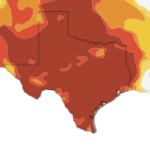How the Drought Exposed Texas’ Water Insecurity
The drought of 2011 may have been the canary in the coal mine of water security for Texas. That was the consensus of a panel of specialists at the 2012 Texas Water Summit hosted by the University of Texas at Austin’s Academy of Medicine, Engineering and Science on Monday.

Graph by NRS Engineers
Texas is now at the same reservoir capacity levels it was during the drought of record in the 1950s.
While the recent drought was no honeymoon, the drought of record in the 1950s stands as a stark reminder of what could come to pass, said Todd Votteler, the Executive Manager of Science, Intergovernmental Relations, and Policy at the Guadalupe-Blanco River Authority. (You can read his presentation here.). Unlike the experience of the past year, the drought of record was the culmination of six to nine very dry years, he said. Emerging from the 1950s, authorities went to great lengths to increase the state’s surface water resources.
Unfortunately, this resource cushion has been all but depleted by the most recent drought experience and a growing population, Votteler said, leaving Texas at the same reservoir storage capacity per capita of 1953, the year that marked the beginning of the drought of record.
So where does the state go from here?
The panel and the summit at large stressed the need to secure reliable sources of water. In 1993, the Texas Legislature retooled the water planning process, but financial resources have never been provided to realize these efforts, according to the panel. This remains a critical barrier to expanding Texas’ water availability.
And if you want to see just how vulnerable the state is, just look to the water systems.
In October 2011, eighty-eight percent of the state was rated as experiencing exceptional drought, putting heavy stress on many of Texas’ water systems. Ron Ellis, a representative of the Texas Commission on Environmental Quality’s (TCEQ) Water Availability Division, said that over fifteen first-time water rights priority calls were made leading to the suspension and curtailment of over 12,000 water rights in the state. Water systems with less than 180 days of water supply remaining were designated as High Priority Public water systems, and the TCEQ was compelled to provide a series of seven emergency planning workshops around the state.
And there was less water for farming and ranching. The increasing trend of water reallocation from agricultural uses to municipal and industrial users over the last decade has considerably decreased water supplies available for agriculture, the panel said. This comes as demand increases particularly due to rice crop irrigation needs. While municipal and industrial needs receive firm water resources that remain available even in the event of a drought, agricultural needs are met by interruptible water sources.
The drought of 2011 saw the unprecedented reduction of these interruptible water resources says LCRA representative Karen Bondy. Farmers were consequently left to weather the dry spell on their own. The economic costs of this situation have been sizable. An earlier report by the Texas AgriLife Extension Service found that total agricultural losses amounted to $7.6 billion.
But the implications of the state’s fragile drought preparedness do not stop there.
The energy-water nexus ensures that any drop in water availability puts our energy security at risk, said Drew Nelson, the Clean Energy Project Manager of the Environmental Defense Fund. “The links between energy and water are significant and are becoming even more significant,” he said.
Water remains a critical component of natural-gas drilling, including hydraulic fracturing. Over thirty billion gallons of water are used for fracking (enough water for every Texan to take forty-eight consecutive showers), Nelson said. Unfortunately, a sizable quantity of the water used for these extraction procedures is non-recoverable, as most fracking water is removed from the water cycle since it is commonly deep-water injected.
If water were to become sparse, this could result in a direct trade-off with the state’s energy resources. When the public is given the choice between drinking water and the 25,000 wells projected in the Eagle Ford Shale for the next twenty years, the public will undoubtedly prioritize drinking water. “This makes water the largest hurdle to gain a public license to drill,” said Nelson.
Aside from these energy concerns, the more than 190,000 miles of aquatic ecosystems in Texas experienced a huge blow. Critically low streamflows and lake levels across the state spelt doom for a number of native species, said Cindy Loeffler, the Water Resources Manager of the Texas Parks and Wildlife Department. At least five native Texas fish species are now extinct, and three more are threatened by local extinction or extirpation. In all, approximately twenty percent of Texas fish are threatened by either extinction or extirpation.
The drought also gave rise to harmful algal blooms known as red tides. As a result of the toxic buildup of algae, aquatic habitats experienced decreased dissolved oxygen levels and paralyzing fish kills. Red tide events along the coastline severely stunted the oyster industry as well.
Given these dramatic consequences of the drought, the panel wondered if the state will be ready for the next drought event. What would we do if the next drought mimicked the drought of record experienced in the 1950s? Or if such a drought were to be far worse, as some tree-ring studies suggest?
For some ideas on how to approach the issues of water security, the summit held panels looking at the examples of San Antonio and Australia. Both of those places stressed conservation, water reuse and desalination. The open question is if Texas will follow suit.





